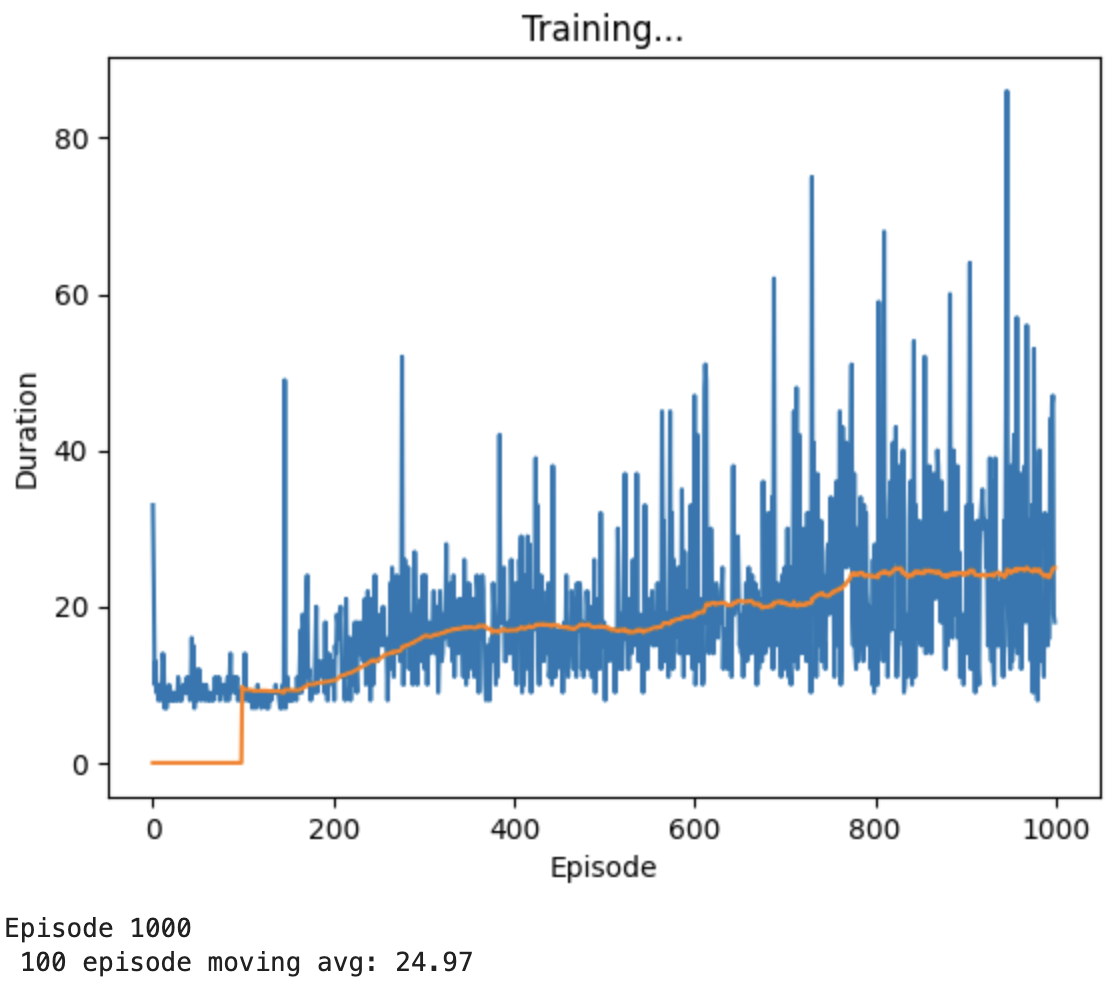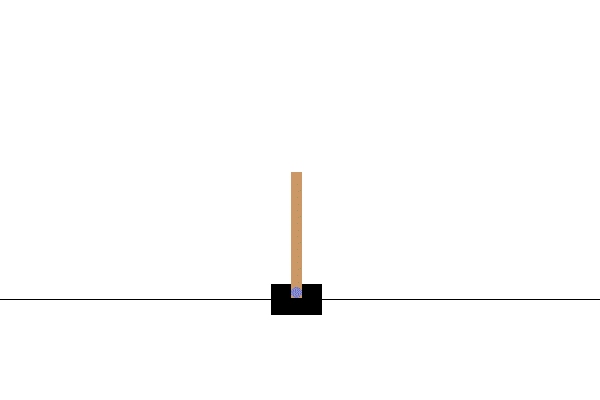来自于旧站的重置文章。
前言
Cart Pole是一个很经典的Reinforcement Learning问题,我们这里就言简意赅了,该问题就是一个小车上面有一个平衡木,要让AI去学习如何让这个平衡木不倒下。
我们这里之所以称之为Deep Reinforcement Learning是因为我们加入了Neural Network神经网络来进行计算,对输入states -> actions, next_states 这样的Q-values进行计算。
我们这里依旧参考的是《Reinforcement Learning - Developing Intelligent Agents》,问题来自于Gym的《Cart Pole - Gym Documentation》。
正文
1. 思路
具体思路来自于《Reinforcement Learning - Developing Intelligent Agents》,我们首先祭出原版的英文思路,避免中文翻译的歧义:
Initialize replay memory capacity
Initialize the policy network with random weights
Clone the policy network, and call it the target networks
For each episode:
Initialize the starting state
For each time step:
Select an action
Via exploration or exploitation
Execute selected action in an emulator
Observe reward and next state
Store experience in replay memory
Sample random batch from replay memory
Preprocesses state from batch
Pass batch of preprocessed states to policy network
Calculate loss between output Q-values and target Q-values
Requires a pass to the target network for the next state
Gradient descent updates weights in the policy network to minimize loss
After x time steps, weights in the target network are updated to the weights in the policy network
下面是中文版:
首先我们需要一个Replay Memory,因为我们的dataset是实时的,并不是固定的,所以我们需要一个Replay Memory去记录我们新的dataset,然后舍去我们老旧的dataset
我们的Policy Network,需要被初始化
其次是我们还创建了一个Network 叫做Target Network,它的作用是,我们在Bellman Equation里面有一步是需要涉及next_state的reward,但是如果我们用Policy Network来计算next_state的reward的话,Policy Network会在next_state改变,这样的话我们的计算会有问题(具体什么问题其实我也没有搞清楚,有懂的亲们可以回复一下,求告诉。0.0。),所以我们打算创建一个固定的Target Network,然后过一段episodes之后再更新这个Target Network。
然后是在每一个episode里面的动作
初始化
对于每一个episode里面的每一个time step
和我们之前讲的一样,我们需要选择一个行为
这个行为可以是exploration或者exploitation的
执行这个行为在模拟器中
得到reward 和 next state
放入replay memory中
当reply memory中的size >= batch size的时候,我们就可以从里面取样了,如果不大于则暂时不取样
数据预处理
将预处理的batch 数据放入policy network中准备进行训练
计算Q-value 和 target Q-value(Target Network中得到)的损失函数
需要一个从target network中得到Q-value的函数
通过梯度下降更新policy network
记住在x时间之后,需要更新我们的target network,否则会和policy network相差太远
思路清楚过后,便是Python源码了
2. Python源码
2.1 Import 与 版本控制
源码设计的包
# Import packages
from collections import namedtuple
from itertools import count
from PIL import Image
import numpy as np
import pygame
import random
import math
import time
import gym
import sys
# Drawing
import matplotlib.pyplot as plt
import matplotlib
is_ipython = 'inline' in matplotlib.get_backend()
if is_ipython: from IPython import display
# PyTorch
import torch
import torch.nn as nn
import torch.optim as optim
import torch.nn.functional as F
import torchvision.transforms as T版本控制
print("Python Version:", sys.version_info)
print("numpy:", np.__version__)
print("gym:", gym.__version__)
print("pygame:", pygame.__version__)
print("matplotlib:", matplotlib.__version__)
print("PyTorch:", torch.__version__)Python Version: sys.version_info(major=3, minor=8, micro=17, releaselevel='final', serial=0)
numpy: 1.24.4
gym: 0.26.2
pygame: 2.5.0
matplotlib: 3.7.2
PyTorch: 2.0.12.2 DQN神经网络
class DQN(nn.Module):
def __init__(self, img_height, img_width):
super().__init__()
self.fc1 = nn.Linear(in_features=img_height*img_width*3, out_features=24)
self.fc2 = nn.Linear(in_features=24, out_features=32)
self.out = nn.Linear(in_features=32, out_features=2)
def forward(self, t):
# because the input size of self.fc1 is (1,x), which is one dimension
t = t.flatten(start_dim=1)
t = F.relu(self.fc1(t))
t = F.relu(self.fc2(t))
t = self.out(t)
return t2.3 实体Entity
自定义数据类型Experience,利于training:
# Python function to create tuple with name field
Experience = namedtuple(
'Experience',
('state', 'action', 'next_state', 'reward')
)Replay Memory,存放和管理training dataset:
class ReplayMemory():
def __init__(self, capacity):
self.capacity = capacity
self.memory = []
self.push_count = 0
def push(self, experience):
if len(self.memory) < self.capacity:
self.memory.append(experience)
else:
self.memory[self.push_count % self.capacity] = experience
self.push_count += 1
def sample(self, batch_size):
return random.sample(self.memory, batch_size)
def can_provide_sample(self, batch_size):
return len(self.memory) >= batch_sizeEpsilon Greedy Strategy,用来改变Exploration rate的函数,决定下一步action是exploration 还是 exploitation:
class EpsilonGreedyStrategy():
def __init__(self, start, end, decay):
self.start = start
self.end = end
self.decay = decay
def get_exploration_rate(self, current_step):
return self.end + (self.start - self.end) * \
math.exp(-1. * current_step * self.decay)Reinforcement Learning Agent,训练的实体,也就是我们的cart pole:
class Agent():
def __init__(self, strategy, num_actions, device):
self.current_step = 0
self.strategy = strategy
self.num_actions = num_actions
self.device = device
def select_actions(self, state, policy_net):
rate = strategy.get_exploration_rate(self.current_step)
self.current_step += 1
if rate > random.random():
action = random.randrange(self.num_actions)
return torch.tensor([action]).to(device) # explore
else:
with torch.no_grad(): # turn off gradient tracking, in this case we just inference not training
return policy_net(state).argmax(dim=1).to(device) # exploitCart-Pole Environment Manager,控制我们的环境:
class CartPoleEnvManager():
def __init__(self, device):
self.device = device
self.env = gym.make('CartPole-v1').unwrapped
self.env.reset()
self.current_screen = None
self.done = None
def reset(self):
self.env.reset()
self.current_screen = None
def close(self):
self.env.close()
def render(self, mode='human'):
self.env.render_mode = mode
return self.env.render()
def num_actions_available(self):
return self.env.action_space.n
def take_action(self, action):
_, reward, self.done, _, _ = self.env.step(action.item()) # item() coz action will be a tensor
return torch.tensor([reward], device=self.device) # datatype consistence is important
def just_starting(self):
return self.current_screen is None
def get_state(self):
if self.just_starting() or self.done:
self.current_screen = self.get_processed_screen()
black_screen = torch.zeros_like(self.current_screen)
return black_screen
else: # middle of the episode
s1 = self.current_screen
s2 = self.get_processed_screen()
self.current_screen = s2
return s2 - s1
def get_screen_height(self):
screen = self.get_processed_screen()
return screen.shape[2]
def get_screen_width(self):
screen = self.get_processed_screen()
return screen.shape[3]
def get_processed_screen(self):
screen = self.render('rgb_array').transpose((2, 0, 1))
screen = self.crop_screen(screen)
return self.transform_screen_data(screen)
def crop_screen(self, screen):
screen_height = screen.shape[1]
# Strip off top and bottom
top = int(screen_height * 0.4)
bottom = int(screen_height * 0.8)
screen = screen[:, top:bottom, :]
return screen
def transform_screen_data(self, screen):
# Convert to float, rescale, convert to tensor
screen = np.ascontiguousarray(screen, dtype=np.float32) / 255 # convert to float, rescale
screen = torch.from_numpy(screen) # convert to pytorch tensor
# Use torchvision package to compose image transforms
resize = T.Compose([
T.ToPILImage() # first transform to PILImage
, T.Resize((40,90))
, T.ToTensor() # then transform to Tensor
])
return resize(screen).unsqueeze(0).to(self.device) # add a batch dime2.4 Helper Functions
Plotting,画图,以visualize我们的结果:
def plot(values, moving_avg_period):
plt.figure(2)
plt.clf()
plt.title('Training...')
plt.xlabel('Episode')
plt.ylabel('Duration')
plt.plot(values)
moving_avg = get_moving_average(moving_avg_period, values)
plt.plot(moving_avg)
plt.pause(0.001)
print("Episode", len(values), "\n", \
moving_avg_period, "episode moving avg:", moving_avg[-1])
if is_ipython: display.clear_output(wait=True)
def get_moving_average(period, values):
values = torch.tensor(values, dtype=torch.float)
if len(values) >= period:
moving_avg = values.unfold(dimension=0, size=period, step=1) \
.mean(dim=1).flatten(start_dim=0)
moving_avg = torch.cat((torch.zeros(period-1), moving_avg))
return moving_avg.numpy()
else:
moving_avg = torch.zeros(len(values))
return moving_avg.numpy()Tensor processing,将我们的Experience处理成tensor进行处理的函数:
def extract_tensors(experience):
batch = Experience(*zip(*experiences))
t1 = torch.cat(batch.state)
t2 = torch.cat(batch.action)
t3 = torch.cat(batch.reward)
t4 = torch.cat(batch.next_state)
return (t1, t2, t3, t4)Q-Value Calculator,我们获得current state的Q-value 和 next state的Q-value的方法(静态函数):
class QValues():
device = torch.device("cuda" if torch.cuda.is_available() else "cpu")
@staticmethod
def get_current(policy_net, states, actions):
return policy_net(states).gather(dim=1, index=actions.unsqueeze(-1)) # predicted Q-values
@staticmethod
def get_next(target_net, next_states):
final_state_locations = next_states.flatten(start_dim=1) \
.max(dim=1)[0].eq(0).type(torch.bool) # find a final state
non_final_state_locations = (final_state_locations == False)
non_final_states = next_states[non_final_state_locations]
batch_size = next_states.shape[0]
values = torch.zeros(batch_size).to(QValues.device)
values[non_final_state_locations] = target_net(non_final_states).max(dim=1)[0].detach() # get batch size Q-values
return values2.5 Main方法
主函数
batch_size = 256
gamma = 0.999 # discount factor in Bellman equation
eps_start = 1 # exploration rate
eps_end = 0.01
eps_decay = 0.001
target_update = 10 # update target network every 10 episodes
memory_size = 100000 # replay memory
lr = 0.001
num_episodes = 1000
device = torch.device("cuda" if torch.cuda.is_available() else "cpu")
em = CartPoleEnvManager(device)
strategy = EpsilonGreedyStrategy(eps_start, eps_end, eps_decay)
agent = Agent(strategy, em.num_actions_available(), device)
memory = ReplayMemory(memory_size)
policy_net = DQN(em.get_screen_height(), em.get_screen_width()).to(device)
target_net = DQN(em.get_screen_height(), em.get_screen_width()).to(device)
target_net.load_state_dict(policy_net.state_dict())
target_net.eval() # not a training net, and will only be used for inference
optimizer = optim.Adam(params=policy_net.parameters(), lr=lr)
episode_durations = []
for episode in range(num_episodes):
em.reset()
state = em.get_state()
for timestep in count():
action = agent.select_actions(state, policy_net)
reward = em.take_action(action)
next_state = em.get_state()
memory.push(Experience(state, action, next_state, reward))
state = next_state
if memory.can_provide_sample(batch_size):
experiences = memory.sample(batch_size)
states, actions, rewards, next_states = extract_tensors(experiences)
current_q_values = QValues.get_current(policy_net, states, actions)
next_q_values = QValues.get_next(target_net, next_states)
target_q_values = (next_q_values * gamma) + rewards
loss = F.mse_loss(current_q_values, target_q_values.unsqueeze(1))
optimizer.zero_grad() # otherwise, accumulate gradient at all backward?
loss.backward()
optimizer.step() # update
if em.done:
episode_durations.append(timestep)
plot(episode_durations, 100)
break
if episode % target_update == 0: # update target_net
target_net.load_state_dict(policy_net.state_dict())
em.close() 2.6 结果
我们1000次的结果如下:

可以看出来我们这一次的Running并没有取得一个很好的结果,可能需要多次重复。虽然相比original而言有所提升,但是与目标值>=195而言相差很远。
我们未来可以采取的方法是:
调整参数(Tune hyperparameters)
调整网络(Change network architecture)
调整算法(Use another algorithm)
调整输入/输出的形式,我们这里用的是图片,不一定是图片,也可以是其他类型的data;或者预处理的方法(Change input format/preprocessing)
总结
总之,昨天重新复习了一下Reinforcement Learning, 今天一脚迈进了Deep Reinforcement Learning的大门。
需要学习的东西,还有很多,加油!
今天比较赶时间,要去做饭了,晚上要回比利时。 0.0!
参考
[1] Reinforcement Learning - Developing Intelligent Agents
[2] Cart Pole - Gym Documentation



